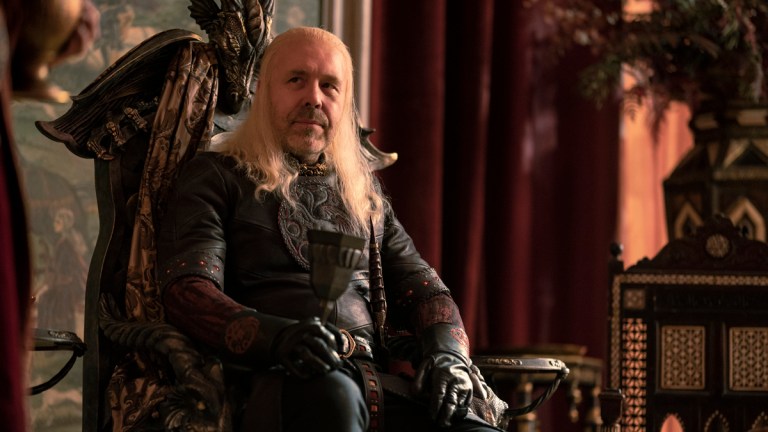What’s Wrong With King Viserys in House of the Dragon?
Paddy Considine’s House of the Dragon character is getting sicker by the episode. What’s eating away at him?

Warning: contains spoilers for House of the Dragon Episodes 1- 3.
It’s not only the attitudes towards women leaders that are Medieval in Westeros, the medicine’s also pretty much from the Dark Ages. The Seven Kingdoms may have magic on their side, but they lack antibiotics. Hence the loss, between House of the Dragon episodes two and three, of a couple of King Viserys I’s fingers.
In ‘The Rogue Prince‘, we saw Viserys receiving treatment for an infected finger cut he’d sustained on the Iron Throne. Said treatment involved submerging his hand in a pile of live maggots to let them eat away the infected, necrotising flesh. It wasn’t enough to save Viserys’ fingers, and we might imagine that the back wound he was being treated for in episode one is similarly festering.
So what does it mean for a king to be eaten away by his very seat of power? One, that irony and symbolism are alive and well in the George R. R. Martin universe. And two, that Viserys might well be lacking in kingly wisdom.
Here’s the reasoning: Viserys is by no means the only king in the George R. R. Martin universe to injure himself on the Iron Throne, an object designed by Aegon the Conqueror, it’s said, to test those who sit upon it. A king must be vigilant, strong and agile; the Iron Throne tests those qualities and punishes those who fail. Allow yourself to be cut by its many blades and perhaps you’re not cut out for the role.
A scene from two centuries later in A Clash of Kings, Chapter 65 shows royal psychopath Joffrey Baratheon cutting himself on one of the legendary throne’s blades. (In the A Song of Ice and Fire books, the throne is a mightier and much more deadly construction than the one popularised by the original TV series.)
Joffrey lurched to his feet. “I’m king! Kill him! Kill him now! I command it.” He chopped down with his hand, a furious, angry gesture… and screeched in pain when his arm brushed against one of the sharp metal fangs that surrounded him. The bright crimson samite of his sleeve turned a darker shade of red as his blood soaked through it. “Mother!” he wailed.
With every eye on the king, somehow the man on the floor wrested a spear away from one of the gold cloaks, and used it to push himself back to his feet. “The throne denies him!” he cried. “He is no king!”
A Clash of Kings, Chapter 65, page 138.
As a Lannister born of incest and no blood relation to his predecessor King Robert Baratheon, Joffrey was not genetically part of the royal line, of course, so the man here interpreting the Iron Throne’s ‘rejection’ of Joffrey makes a kind of symbolic sense.
Viserys’ descendant, the Mad King Aerys II, was part of the royal bloodline, but as his epithet shows, similarly unfit to rule. In fact, the father of Daenerys Targaryen memorably earned himself a second nickname as “King Scab” for his many injuries caused by the Iron Throne. In A Feast For Crows, Chapter 16, it’s said of Aerys, “Yet still the blades tormented him, the ones he could never escape, the blades of the Iron Throne. His arms and legs were always covered with scabs and half-healed cuts.”
The Iron Throne even went so far as killing one king, or so the story goes. King Maegor the Cruel – the Targaryen it was feared that Prince Daemon would most resemble were he to be crowned – was found bled to death on the throne, with the cause of his demise unclear. Had Maegor decided to take his own life and used the royal chair to do the deed? Had he been stabbed by his wife, an enemy, or (somehow) by the throne itself?
Everyone’s a critic, it appears, even the palace furniture. If Viserys’ throne injuries are indications that he’s not doing a bang-up job ruling the Seven Kingdoms, would that be that a fair judgement? Consider the moves he’s made so far: choosing his dream of a male heir over the life of Queen Aemma (and losing them both), furthering the rift with the powerful House Velaryon by rejecting their daughter in marriage, and making an enemy of his brother Daemon by naming Rhaenyra his heir. None of them acts of kingly genius. (The finger cut, by the way, happened immediately after Viserys banished Daemon, perhaps warning of dangerous future consequences.)
As a prequel, House of the Dragon fans know that the Targaryens are not on the rise but on the way out. That could give Viserys’ festering wounds another layer of symbolism, signifying the incest-bred rot of instability and cruelty that establishes itself in the Targaryen bloodline, which so memorably – and controversially – came out in Queen Daenerys in Game of Thrones‘ final season.
Whatever finally does for King Viserys I in House of the Dragon (which may turn out to have its own twist on the Fire & Blood source material), it’s already obvious that his reign is sowing the seeds of future discord. The more dangerous decisions, the more injuries. Will his be a death by a thousand cuts?
